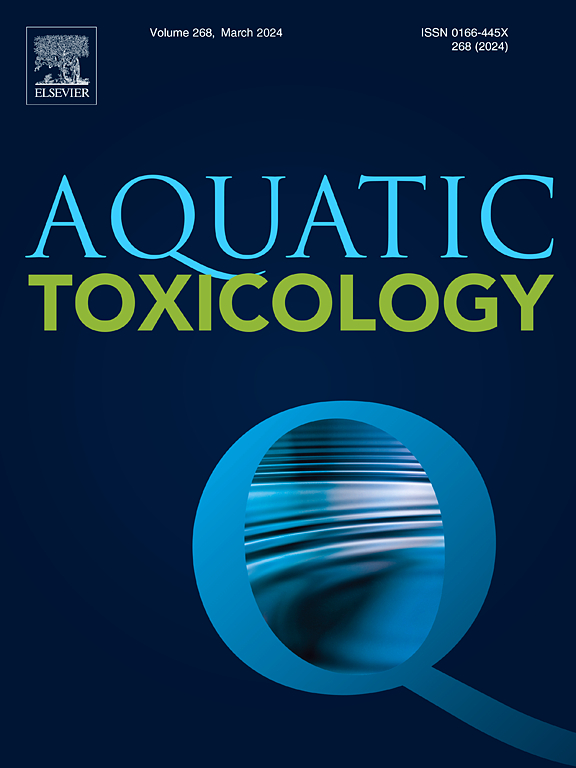Low lipid levels caused by bisphenol S exposure trigger neuroinflammation and apoptosis in the brain of zebrafish
IF 4.1
2区 环境科学与生态学
Q1 MARINE & FRESHWATER BIOLOGY
引用次数: 0
Abstract
Bisphenol S (BPS), as an environmental pollutant, is known to reduce brain lipid levels and induce neurotoxicity. However, whether brain lipid imbalance can induce neurotoxicity has not yet been clarified. Here, wild-type zebrafish and apoEb mutant zebrafish were used to investigate the effect of BPS on the macrophages proliferation and microglia mobilization caused by the decrease of cerebral lipids and its potential neurotoxic effects. The zebrafish exposed to BPS (1, 10, or 100 μg/L) from 2 hours after fertilization (hpf) to 3 days after fertilization (dpf) displayed microglial aggregation, as well as a decrease in brain lipid content. Lipidomic analyses of the brains and plasma of 50 dpf zebrafish exposed to BPS were used to identify key lipids, including lysophosphatidylcholine and phosphatidylcholine in brain and phosphatidylcholine in plasma. The apoEb mutant zebrafish as a hyperlipidemia model was used to further demonstrate that BPS-induced lipid reduction increased the number of microglia in the brain. Our data provide new insight into the mechanism by which pollutants cause neurotoxicity.
双酚S暴露引起的低脂水平引发斑马鱼大脑神经炎症和细胞凋亡
双酚S (BPS)作为一种环境污染物,具有降低脑脂质水平和诱导神经毒性的作用。然而,脑脂质失衡是否会引起神经毒性尚不清楚。本研究以野生型斑马鱼和apoEb突变斑马鱼为研究对象,研究BPS对脑脂质降低引起的巨噬细胞增殖和小胶质细胞动员的影响及其潜在的神经毒性作用。从受精后2小时(hpf)到受精后3天(dpf),暴露于BPS(1、10或100 μg/L)的斑马鱼出现小胶质细胞聚集,脑脂质含量下降。对暴露于BPS的50只dpf斑马鱼的大脑和血浆进行脂质组学分析,以确定关键脂质,包括脑中的溶血磷脂酰胆碱和磷脂酰胆碱以及血浆中的磷脂酰胆碱。利用apoEb突变斑马鱼作为高脂血症模型,进一步证明bps诱导的脂质降低增加了大脑中小胶质细胞的数量。我们的数据为污染物引起神经毒性的机制提供了新的见解。
本文章由计算机程序翻译,如有差异,请以英文原文为准。
求助全文
约1分钟内获得全文
求助全文
来源期刊

Aquatic Toxicology
环境科学-毒理学
CiteScore
7.10
自引率
4.40%
发文量
250
审稿时长
56 days
期刊介绍:
Aquatic Toxicology publishes significant contributions that increase the understanding of the impact of harmful substances (including natural and synthetic chemicals) on aquatic organisms and ecosystems.
Aquatic Toxicology considers both laboratory and field studies with a focus on marine/ freshwater environments. We strive to attract high quality original scientific papers, critical reviews and expert opinion papers in the following areas: Effects of harmful substances on molecular, cellular, sub-organismal, organismal, population, community, and ecosystem level; Toxic Mechanisms; Genetic disturbances, transgenerational effects, behavioral and adaptive responses; Impacts of harmful substances on structure, function of and services provided by aquatic ecosystems; Mixture toxicity assessment; Statistical approaches to predict exposure to and hazards of contaminants
The journal also considers manuscripts in other areas, such as the development of innovative concepts, approaches, and methodologies, which promote the wider application of toxicological datasets to the protection of aquatic environments and inform ecological risk assessments and decision making by relevant authorities.
 求助内容:
求助内容: 应助结果提醒方式:
应助结果提醒方式:


